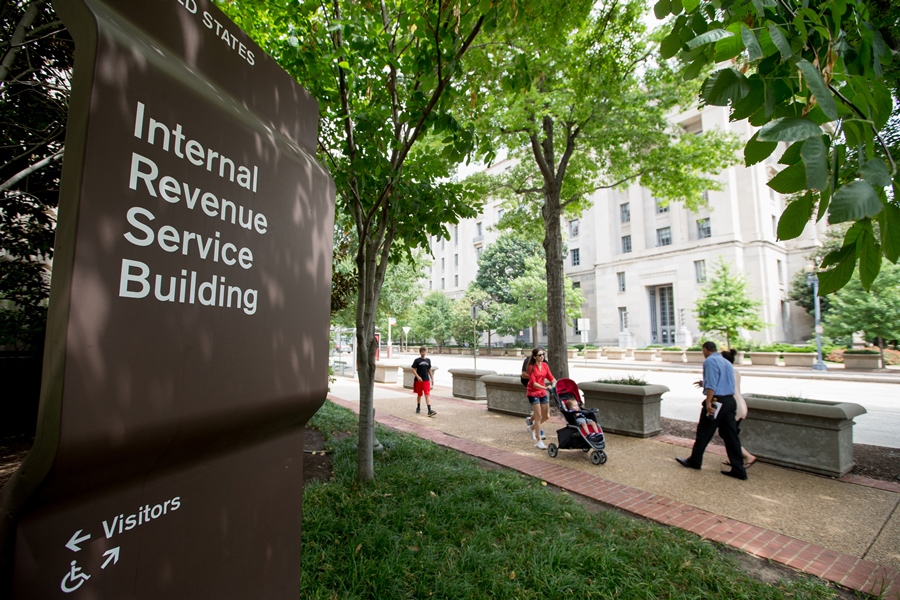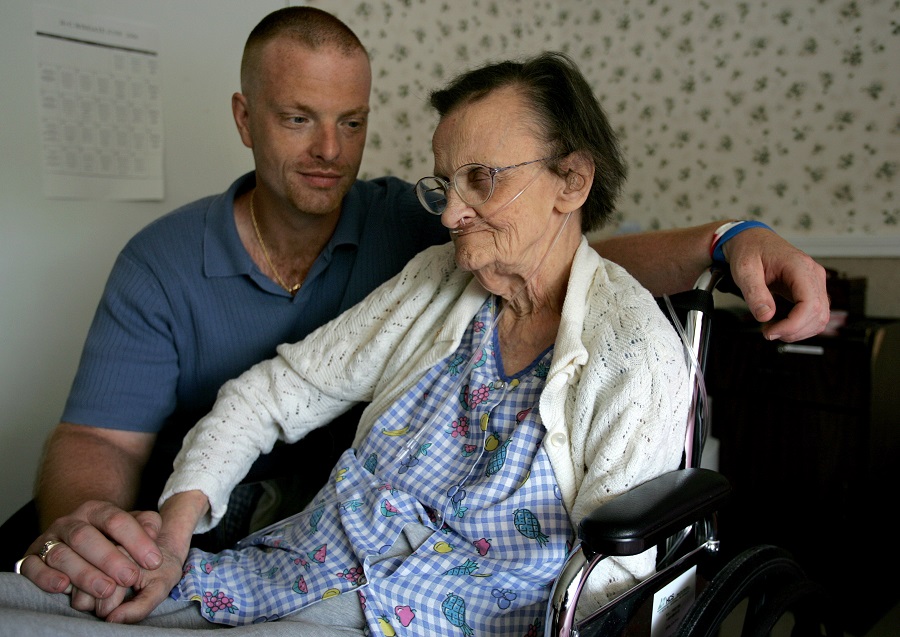(Bloomberg) -- It's the economy again, stupid.
|The presidential race between Hillary Clinton and Donald Trump has beendominated by debate over job creation, retirement, and other tenets of economicsecurity, along with looming questions over race in America andthreats from abroad.
|The future of Social Security makes up two of the top 10crowdsourced and crowd-voted questions the public wantedanswered in the second presidential debate. The questions on theOpenDebate Coalition's website are pointed:
Do you support expanding, and not cutting, Social Security'smodest benefits?
Social Security is not an entitlement or a handout, how are yougoing to save it?
What's your plan to target the large public health crisis:Alzheimer's disease?
Jobs, taxes, child care, and health care are also among the topics peoplewould like Hillary Clinton and Donald Trump to address.
|Here's a cheat sheet summing up their positions onsome of these issues and, since there's no time like the present,ways you can improve your finances no matter who movesinto the White House in January.
||
The U.S. minimum wage, its role in the economy, and thecandidates' broader prescriptions for wage and job growth haveimplications for your working life and your retirement, even if youmake far more than that. (Photo: AP)
|Clinton and Trump on jobs
Clinton
|The Democratic candidate vows to narrow the income gap. Hercampaign promises "the largest investment in good-paying jobs sinceWorld War II," including a $275 billion plan to rebuild U.S.infrastructure, the creation of jobs in alternative energy, andsupport for small manufacturers and startups.
|Clinton would pursue "smarter, fairer, tougher trade policiesthat put U.S. job creation first," work with organized labor,gradually raise the minimum wage from $7.25 to $12 an hour, andsupport efforts by cities and states to raise that minimumfurther, citing the "Fight for $15."
|Trump
|Trump also talks of raising the standard of living and says hispolicies will make America "the best place in the world to get ajob" but stresses getting out of the way of economicgrowth.
|That means rolling back regulations on energy and otherindustries, reworking trade agreements that "create a smallereconomy for everyone," overhauling the tax code,and raising barriers to immigration. Trump wants to spendmore than $500 billion on infrastructure. He has said theminimum wage should be up to the states but has also talkedabout a $10-an-hour federal floor.
|You and your money
|Raising the minimum wage could cost us jobs, someargue. The Congressional Budget Office, in a 2014analysis, noted that "business owners would see reductions inreal (inflation-adjusted) income, as would consumers, who wouldface higher prices as a result of the minimum-wageincrease."
|The article "Minimum Wage Mythbusters," on the U.S. Department ofLabor's website, says raising the minimum has "little tono effect on employment as shown in independent studies fromeconomists across the country," citing research showing that"higher wages sharply reduce turnover which can reduce employmentand training costs."
|Moody's Analytics concluded in a macroeconomicanalysis of Clinton's economic proposals that the "negativeemployment affect" of a higher minimum wage would be modest, sincethe floor would be phased in over five years.
|Whether or not you are directly affected by the minimum wage,its role in the economy and the candidates' broader prescriptionsfor wage and job growth have implications for your working life andyour retirement.
|What you can do
|Guard against lifestyle inflation that caneasily creep into your spending. Tamping it down earlyon, to add to your savings, can pay off handsomely in the longterm, since most big raises come earlier in your career.
|Gains slow in your 40s and 50s, and in your 50s incomegrowth, adjusted for inflation, generally turns negative,according to financial planner Michael Kitces.
|With less earning power ahead of you and your options to dealwith savings shortfalls narrowing, you may have to make painfulspending cuts or reduce your expectations for retirement.
|So if economic growth picks up, and with it your pay, try tokeep your spending the same.
|Kitces suggests setting a lifestyle spending target—how much youwant to be able to spend per year in retirement—ratherthan framing it as saving 10 percent or 20 percent of currentincome. Because he aims to save the equivalent of his annualspending times 30, he looks at everything he thinks about buying ascosting 30 times as much as it does.
||
Start thinking about year-end moves to lessen thepain of paying income taxes next April. (Photo: AP)
|Clint and Trump on taxes
Clinton
|Clinton would raise taxes on high earners in a variety of ways.Her plans include a minimum rate of 30 percent for anyonewith income of more than $1 million, a 4 percent surcharge on grossadjusted income over $5 million, a $1 million limit on the lifetimegift exemption, and a new tax schedule on capital gainsrates.
|A cap on the amount of savings from itemized taxdeductions would limit them to 28 percent of the value of thededuction. So those in higher tax brackets wouldn't get a greaterbenefit from, say, taking the mortgage interest deduction, the TaxFoundation notes.
|Clinton would lower the starting point at which estates aretaxed to $3.5 million ($7 million for married couples) and raisethe top estate tax rate to 45 percent from 40 percent. Estatesvalued at over $1 billion per couple would pay a 65 percentrate.
|She'd also seek to limit the ability to pass on appreciatedassets to heirs free of capital-gains taxes before death, thoughshe'd protect "small and closely held businesses, farms and homes,and personal property and family heirlooms.”
|Trump
|The number of income-tax brackets would shrink from seven tothree in Trump's tax-reform plan—12 percent on income up to$75,000, 25 percent for $75,000 to $225,000, and 33 percent onincome over that. So top earners would no longer face a 39.6percent tax bracket.
|The standard deduction for single filers would be $15,000, and$30,000 for joint filers. Itemized deductions would be cappedat $100,000 for single filers and $200,000 for married couplesfiling jointly. Trump would kill the estate tax and keepthe popular mortgage interest deduction.
|You and your money
|Clinton's approach would cost wealthy families themost, while they would appear to benefit under Trump. Whateverhappens in the end, the debate over taxes is a good reminderto pay attention to the tax treatment of your investments.Vigilance can boost your income in what could be a low-returnenvironment if the economy continues on its current path.
|What you can do
|Start thinking about year-end moves to lessen the painof paying income taxes next April. For the longer term, calculatewhat your total annual income from Social Security and othersources would be in retirement, and what the federal and statetaxes on that income could be.
|The first of the baby boomers just hit 70 and a half, when theyhave to start taking required minimum distributions from IRAs.These annual withdrawals can push people into a higher taxbracket.
|Financial planners suggest strategies using a variety ofretirement accounts to try to minimize the tax bite. Touse that strategy effectively, you have to explore it wellahead of time.
|By shifting money between traditional IRAs and Roth IRAs andother accounts, and paying tax on some accounts at opportune times,you can lessen the tax bite and add years of retirementincome.
||
With pension plans receding and many workers without planssuch as 401(k)s, Social Security is more important than ever.(Photo: Getty)
|Clinton and Trump on Social Security
Clinton
|Social Security would be modestly expanded, increasingbenefits for widows and giving credits to workers who take ajob leave to care for family members. To raise funds for theprogram, Clinton would increase the level of annual wagessubject to payroll taxes; in 2016, wages aren’t taxed after$118,500.
|According to a 2014 analysis by the Center for Economic & PolicyResearch, the wealthiest 6.1 percent of workers would paymore if the payroll cap were removed.
|Changes to Social Security that Clinton opposes include reducingcost-of-living adjustments, attempts at privatization, anincrease in the retirement age, and any attempts "to close thelong-term shortfall on the backs of the middle class."
|She has vowed to fight any Republican plans “to privatizeor ‘phase out’ Medicare as we know it” and has said she would workto drive down drug prescription costs.
|Trump
|Trump tweeted in May of last year that he was "the first& only potential GOP candidate to state there will be no cutsto Social Security, Medicare & Medicaid."
|Growth from implementation of his economic policies would “shoreup our entitlement plans for the time being,” he has said. Yethe has also noted that “as our demography changes, a prudentadministration would begin to examine what changes might benecessary for future generations."
|You and your money
|With defined-benefit pension plans fast receding and manyworkers without defined-contribution plans such as 401(k)s, SocialSecurity income is more important than ever for more people—even asit isn't nearly enough for most of us to realize our retirementplans.
|Clinton’s plan for payroll taxes would mean a pay cut for anyonemaking over $118,500; right now, anyone making $237,000 a year, ortwice the cap, stopped paying payroll taxes on earningson July 1.
|But if changes aren't made to shore up the program's financesbefore 2034, automatic reductions in benefits will kick in, withclaimants getting just 75 percent or so of theirscheduled benefits.
|What you can do
|Many people aren't clear on how to get the biggestbenefit from the Social Security program. That’s why "GetWhat's Yours," a guide to maxing out Social Security benefits bythe economist Laurence Kotlikoff, became abestseller. One of his co-authors, Philip Moeller, has thesame sort of book coming out in early October, on gettingthe most out of Medicare.
|Studying the rules can ensure a more comfortable retirement. Forexample, if you were born after 1943 and wait to claim benefitsafter the full retirement age (67 for anyone born in 1960 orlater), benefits rise 8 percent a year until age 70. Tryfinding a safe 8 percent return anywhere else.
|One of the smartest moves to prepare for the cost of retirement,even if you can't save much now, is something many younger saversare already doing—simply staying fit and healthy. Unexpectedhealth-care costs can derail the best-laid retirement plans. (And,though it's just a correlation, men who worked out three or moretimes a week made about 6 percent more than men who didn't,according to a 2011 study from Cleveland StateUniversity. The gap was about 10 percent forwomen.)
||
The cost of child care tops college tuition inmany states. (Photo: AP)
|Clinton and Trump on child care
Clinton
|Clinton would cap the cost of a family’s child care at 10percent of household income using tax credits and subsidized childcare. She has talked about a national system for paidfamily leave of up to 12 weeks as well as universal preschool forfour-year-olds.
|Child-care workers would be paid better. ("In many places, dogtrainers are paid more than child-care workers," she has said.)Child care is part of Clinton's "New College Compact," whichproposes significant improvements for child care on campus andup to $1,500 a year in scholarships to college students who areparents.
|Trump
|Trump has promised a mandatory six-week paidmaternity leave and would let parents deduct the costs ofraising a child up to age 13, for up to four kids. Tohelp lower-income taxpayers who may not pay income tax, the EarnedIncome Tax Credit would be raised to "half of the payrolltaxes paid by the lower-earning parent,” with an income limit of$31,200 for single taxpayers and $62,400 for jointfilers.
|Trump's plan would let parents create dependent-caresavings accounts. Contributions would max out at $2,000 a year, andearnings would accumulate tax-deferred. Balances could berolled over and used for higher education when a child turns 18.The annual cap on the business tax credit for child care thatemployers offer on site would rise from $150,000 to $500,000.
|You and your money
|The cost of child care tops college tuition in manystates, according to a 2015 report from the Economic Policy Institute (EPI), a liberal think tank,as well as monthly rent. Corporate day-care centers would be idealfor many parents but are far and few between, so any reliefwould be a big help.
|Some employees already have access to dependent careflexible savings accounts (FSAs). The Tax Policy Center has said Trump’s proposal“would mostly benefit high-income families who need governmentchild care subsidies the least” and that “for those who need it themost, such as low-income married couples with a single earner,there is much less to Trump’s plan than meets theeye.”
|What you can do
|This is a tough one. If you want to gather support among otherworking parents at your company and raise the prospect ofon-site day care, you can show your employer this article aboutthe positive experience that such companiesas Patagonia and Goldman Sachs have had with sucharrangements.
|Creative solutions are cropping up for some parents, such as theWorkaround, in Brooklyn, N.Y., a co-working space where people earncredits for watching one another's kids, which they can usewhen they need child care.
|If your company offers a dependent care FSA, try to fund itfully. It lets you pay for child care out of pretax pay,which makes it stretch further while loweringyour taxable income. In 2016, the limit on what you couldcontribute tax-deferred was $5,000 for a married couple filing ajoint return. Also, take advantage of any discounted grouplegal services offered through your benefit plan to make a will, ifyou haven't already, and of any elder care programsoffered.
||
The massive wave of aging baby boomers means Alzheimer’swill soon affect even more lives. (Photo: AP)
|Clinton and Trump on Alzheimer’s disease
Clinton
|The candidate's website states that "we can prevent,effectively treat, and make an Alzheimer's cure possible by 2025."As president, Clinton would invest $2 billion a year toresearch the disease and create a team of the "best andbrightest" among researchers and health experts.
|She'd have Medicare cover "comprehensive Alzheimer'scare-planning sessions and the cost of property documenting everydiagnosis and care plan." The Social Security Administration wouldbe directed to inform seniors of "wellness visits, cognitivescreenings, and other preventive benefits covered by Medicare." Thecampaign hasn't said exactly how these initiatives wouldbe funded.
|Trump
|Trump doesn't mention Alzhiemer’s on his site. In 2015, at atown hall in Hampton, New Hampshire, an audience member asked Trumpwhat he would do about the disease. He said it is “a total priorityfor me. I have so many friends whose families have beendevastated.” His own father was diagnosed with Alzheimer’s in 1993and died in 1999.
|You and your money
|The massive wave of aging baby boomers means Alzheimer’s willsoon affect even more lives than it already does. In 2015, therewere 73 million voters who had a close friend or family member withAlzheimer’s, according to a survey by the Alzheimer’s Association, and an estimated 18.1 billionhours of unpaid care were devoted to patients bycaregivers. The average cost of caring for someone with thedisease is more than $5,000 a year, and it will costs taxpayers$236 billion in 2016, the Association estimates.
|What you can do
|Researching the costs involved will give you a sense of thefinancial burden of caring for someone with Alzheimer’s, if youneed any more motivation to save. The Alzheimer’s Association listsaverage costs for long-term-care services,based on a 2015 Genworth Financial survey.
|More financial advisers are working with clients to prepare forany possible cognitive decline. Certified financial planner TimKober, of Beaverton, Ore.-based Cedar Financial Advisors, said hehelps clients develop a plan, which they sign, in case they sufferfrom “diminished capacity.” They decide what to do, and whom Kobershould speak with, if he thinks diminished capacity is anissue. “It’s an elegant workaround to privacy issues, and it’s beenconsistently received positively by clients,” he said.
|Copyright 2018 Bloomberg. All rightsreserved. This material may not be published, broadcast, rewritten,or redistributed.
Complete your profile to continue reading and get FREE access to BenefitsPRO, part of your ALM digital membership.
Your access to unlimited BenefitsPRO content isn’t changing.
Once you are an ALM digital member, you’ll receive:
- Critical BenefitsPRO information including cutting edge post-reform success strategies, access to educational webcasts and videos, resources from industry leaders, and informative Newsletters.
- Exclusive discounts on ALM, BenefitsPRO magazine and BenefitsPRO.com events
- Access to other award-winning ALM websites including ThinkAdvisor.com and Law.com
Already have an account? Sign In
© 2024 ALM Global, LLC, All Rights Reserved. Request academic re-use from www.copyright.com. All other uses, submit a request to [email protected]. For more information visit Asset & Logo Licensing.








